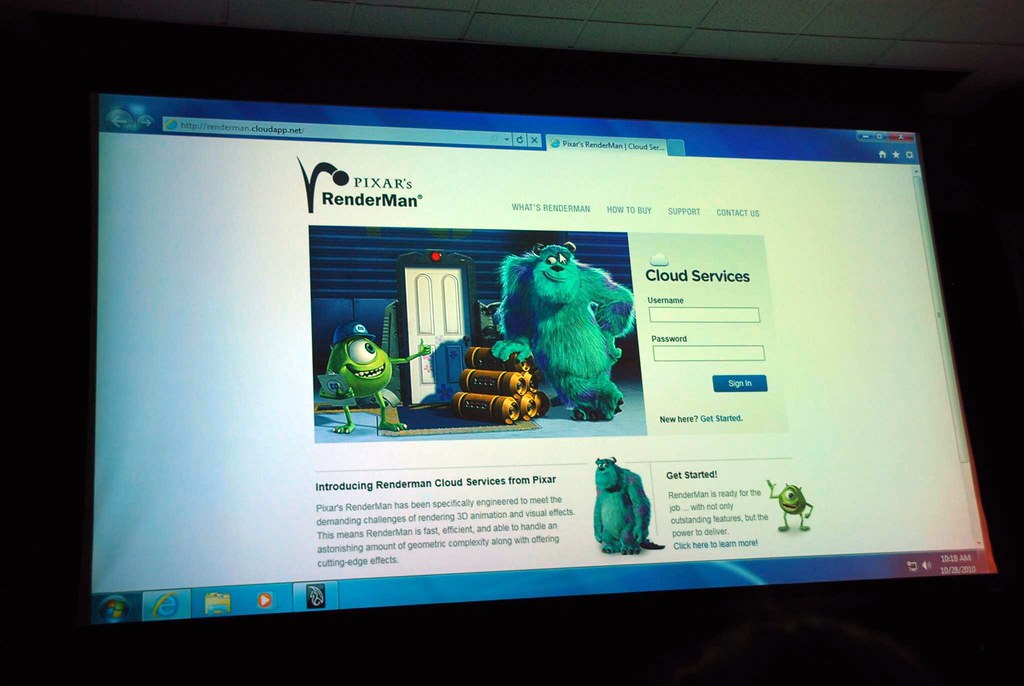Light, camera ... cloud: How clouds change the movie industry

Would you prefer 10,000 hours of footage processing on 100 machines or one hour per 1,000,000 machines? Same price. Welcome to the cloud.
As in the case of football , at first glance it is not clear how cloud solutions and the film industry are related. But if you look at the methods used in the production of films, the reasons for using cloud systems become obvious.
')
There are two main ways to use cloud technology designers and companies involved in animation, motion and VFX:
- Rendering is a vital part of the equation. Due to the complexity of the tasks and the high cost of equipment, it is increasingly being transferred to the cloud.
- Storing materials is also important, especially when working simultaneously with teams from different countries. But in terms of work on the "picture" this question is secondary.
If you look at a beautiful 3D image, you will not immediately realize that this is not a real photo. Yes, the computer must have the highest performance to display it. The rendering process is one of the most energy-intensive aspects of filmmaking: combining all movie scenes with visual effects and sound can take a very long time and will require huge computational resources.

Therefore, the main obstacle to creating realistic images, even more real than the camera is capable of capturing, is the lack of computing power and more advanced 3D rendering programs.
Cloud rendering removes one of the biggest barriers to entry into the VFX industry: infrastructure. Most recently, VFX companies built large data centers, “rendering farms,” with thousands of processors capable of working in tandem to render a single angle, shot, or scene, including third-party rendering farms. Nobody wants to return to this method.
What do movie studios think
Simple calculation: just one realistic frame consumes more than 4 GB of physical memory and 512 MB of graphics memory. To create one minute of video, you will need at least 30x60 = 1800 such frames. For this you need a huge resource. This issue is especially relevant for the Pixar, Disney and DreamWorks Animation studios, which create fantastic animation. By the way, back in 2010, Pixar talked about the benefits of cloud rendering on the example of the cartoon films “Toy Story”, “Monsters Inc.” and “Up”.

Instead of trying to find computers that can handle a huge workload, many studios use cloud computing capabilities. Remote use of computational power allows you to finish a project much faster than when working on companies' own equipment.
Afterglow Studios , based in Minneapolis, USA, and working with Disney, offers tremendous power for cloud-based 3D rendering. According to their calculations, the four-second animation takes about 10K computational cycles, which guarantees a beautiful and realistic animated frame. To create the same render farm, studios will need a lot of time and even more money.
In an interview with BBC News, a spokesman for Atomic Fiction said it was necessary to use cloud solutions, thanks to which small studios remain competitive and produce a high-quality film product.
Laurent Tylefer , Head of Computer Graphics at the Canadian-American VFX Studio:
“The number of frames we work with and the level of detail - for example, photorealistic reconstruction of Manhattan for Robert Zemeckis' Walk” - require computational capabilities that would imply huge investments. Such costs would make our studio competitive.
In “Deadpool” on some frames of the city there were so many details in the models and textures that rendering the final images required much more memory than standard computers can give. "Clouds" provided us with this missing power, creating extremely complex and realistic shots. "

“We knew that we had no budget for a large data center. But we didn’t want to be a data center, we wanted to be a creative company ",- echoes the visual effects manager Kevin Bailey .
“While working on the film“ The Crew, ”we started with 130–140 VFX shots, but eventually we came close to 400. Since we had a cloud, it was easy to build up capacity. It would be physically impossible to build a traditional rendering farm and perform the necessary VFX in such a short time. ”
One of the most technically challenging Disney movies, “City of Heroes” (Big Hero 6) was rendered on 55,000 cores , and it took 190 million render-hours. Especially for managing the cloud, geographically distributed over four render farms, the system of assignment of tasks CODA was written.
Another example of successful cloud computing use was brought by director and VFX designer Scott Pagano, who creates live 3D images for musicians such as Skrillex, Flying Lotus and Zedd. One of the artists needed a VFX design for the entire live show four days before the date of the concert. It was not easy, but thanks to the "clouds" all the visual effects in 2K format were ready by the deadline.
Advantages of cloud 3D rendering over traditional filmmaking
Working materials for the film can be as large as petabyte data. And all this data must be moved, processed and uploaded by various teams involved in the stages of film production. Thus, the advantages of placing it in a remote and secure, but accessible place become obvious.
- Everything is done literally at the table, on a regular computer;
- Producers, director of the film and other managers receive a guarantee of high-quality “pictures” and meeting deadlines;
- It is easier to perform “transformations” of a person - into a bee, an ant, a mutant;
- Caring for the environment - cloud infrastructure is more efficiently organized than the traditional one. For the same amount of work, less electricity is needed, which is good;
- Continuous availability - cloud solutions provide easy access to materials and allow users to work in different time zones and geographic locations;
- You can create digital twins of actors , making them younger, sportier, more attractive;
- Fast scaling - to increase the detail of the frame, you do not need to purchase additional equipment. It is enough to add cloud resources to those already used.
Real-time rendering
Another interesting technology that enhances the performance of cloud rendering farms is the graphics processor (GPU). GPU rendering has long been used by igrodelami to create stunning real-time graphics. But for VFX companies, cloud graphics are a poorly explored territory.
More recently, Adobe Premiere Pro (and the rest of the Adobe Creative Suite) have enabled some Nvidia GPUs to do the heavy rendering work. Until that time, VFX companies had to buy expensive graphics cards with graphics processors and software licenses for their own server systems.
New technologies (like Otoy Octane ) are more widely using the capabilities of GPUs and make cloud computing cheaper, even ahead of Amazon solutions. With their help, VFX designers can perform real-time rendering, including extremely complex operations like ray tracing in the cloud. Video card maker Nvidia demonstrated this technology while performing in San Diego. He performed real-time rendering on a MacBook Air using a virtual machine tied to a GPU rendering farm in Los Angeles. Nvidia recently talked about how far they have come in this direction.
Why film studios still have not switched to the "clouds"?
1. Skepticism
Nobody argues, cloud computing is a huge help for the industry during the post-production phase. However, skepticism about these technologies persists. Indeed, in the film industry, it is important to maintain complete secrecy until such time as the film is not released. Such behavior is fully justified - a copy of the film merged into the Internet can theoretically be great at reducing box office. Although there are different opinions .
Some studios guarantee peace of mind by creating their own private cloud systems. As a result, they do not need the power of cloud companies. And they consider themselves more secure than if they used the same cloud systems as Netflix, Amazon, and Google. In fact, these are enormous expenses for studios, especially small ones. And such expenses are not always justified.
In addition, companies offering "clouds" are themselves interested in protecting client content. Therefore, they often have stricter security requirements and multi-level protection systems. That is, the studios get a well-protected storage, and at the same time do not spend on protecting their content.
2. Unwillingness or lack of ability to change the model of work with data
Many Hollywood studios have already spent a lot on their own data centers and private clouds, so they are not ready to abandon these investments. Even knowing that there are cheaper alternatives, they will squeeze the maximum out of available capacity, as long as it is economically feasible. Own data center is an extremely complex and costly project to so easily abandon it. Especially if the previous tape failed at the box office, “knocking down” the studio budget.
This approach is quite understandable. But we must remember that its own infrastructure will be enough to create high-quality graphics only up to a certain limit. Subsequently, you still have to allocate funds for the modernization of equipment and the expansion of the premises to supply new equipment. Or go to the "cloud", reducing the amount of capital expenditures.
3. Weak internet
Suppose a studio renders at 30 frames per second. Each frame can take up to 100 megabytes. Therefore, the volume of transmitted data becomes completely unmanageable if the network in which the VFX designer works is bad. In addition, the loading and unloading of data in the huge quantities required by the film project can still take a lot of time.
The question is solved quite simply - connecting a more powerful Internet channel, which even for small studios is not such a difficult task.
Conclusion
We have not always had IMAX cinemas, 3D movies and augmented reality applications. This was made possible thanks to powerful servers, almost unlimited storage, high-speed Internet and ingenious software. Better video resolution, frame rate and color depth require more from the IT infrastructure.
Technology allows TV and film companies to produce, edit, refine and deliver cleaner, clearer and more realistic content faster and at lower cost. Viewers enjoy 3D, 2K, 4K, 8K, HFR, UHDTV and other quality video. Artists and designers create stunningly realistic images using cloud computing.
In conditions of tight deadlines for projects and competition for new projects, studios often have to quickly build up their IT infrastructure in order to return to schedule or increase capacity for new victories. Expanding your own infrastructure through the use of cloud resources, gaining access to more computing power during peak periods and the acceleration of large or late projects are an increasingly popular phenomenon in the production of feature films and other video.
Storage in remote clouds also plays an important role in ensuring collaboration and archiving. 48 percent of specialists in the annual survey conducted in 2018 use cloud storage for editing and subsequent processing of video materials.
Source: https://habr.com/ru/post/454274/
All Articles